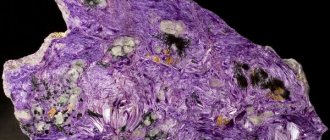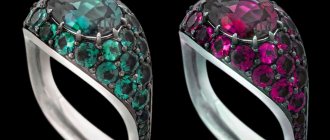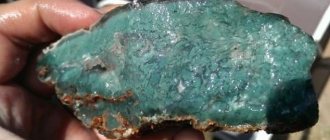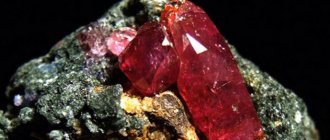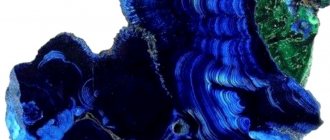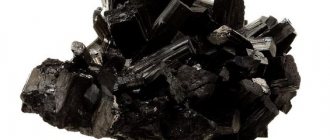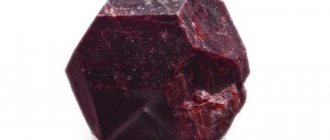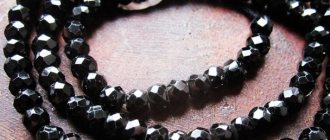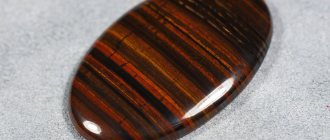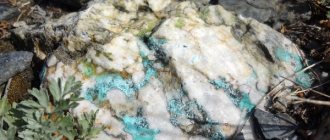| Category | Oxides |
| Title in English | Ruby |
| Formula | Al2O3 |
| Group | Corundum group |
| Color | Red, Red-brown, Red-purple, Red-pink |
| Stroke color | White |
| Shine | Glass |
| Transparency | Transparent |
| singonia | Trigonal |
| Hardness | 9 |
| Cleavage | Imperfect |
| Density, g/cm³ | 3,99 — 4,10 |
| Kink | Conchoidal |
| origin of name | The name for this corundum was created from the Latin word rubens or also rubinus, which translates as blushing. |
Ruby is a variety of corundum, namely aluminum (III) oxide with chromium impurities, which gives it an unusual red hue. Artificial ruby was first synthesized by the French chemist O. Verneuil in 1904. Rubies have found use in the jewelry and watch industries, as well as in quantum electronics.
Ruby deposits
Deposits of this precious stone are located on all continents, with the exception of Antarctica.
The most ancient of them were discovered in the Pamirs (Snezhnoye, Tajikistan). — Advertising —
The main modern exporting countries are Myanmar, Thailand and Sri Lanka. Rubies found in eastern Africa (Kenya, Tanzania) are also of good quality.
As an accompanying material, rubies are found in the south of the Urals, in the north of Karelia, and on the Kola Peninsula.
Ruby history
During the Middle Ages in Rus', rubies were not distinguished from sapphires and both stones were called “yakhonts”.
The phonetic path of this word began with the Greek “yaksintos”, which passed into the Persian “yakund”, then into the Arabic “yakut” and the Slavic “yakhont”. And the word "ruby" comes from the Latin "rubeus", which refers to its red color. Rubies have been known to man for a very long time; they were mined in Burma during the Bronze Age. These stones were valued and used as talismans in Ancient India, Greece and Rome. Thus, in the main temple of the ancient Greek city of Hierapolis there was a gilded statue of Zeus’s wife, Hera, decorated with large rubies. In the Middle Ages, rubies were recognized as a symbol of Fire, and the sun was considered its patron.
— Advertising —
A related line of rubies and sapphires was discovered in 1800 in Europe. And in 1960, scientists first created a solid-state laser using this stone.
Energy potential of pyrope
In ancient times, the red pomegranate was considered a talisman that instills cheerfulness and cheers the heart. You cannot wear such amulets all the time. In ancient treatises it is described as a healing stone that “creates blood,” that is, giving life force. It promotes blood circulation, nourishes the cardiovascular system, and strengthens the immune system. The active field of the mineral can cause, if worn constantly, energy oversaturation and hyperactivity.
Women are especially fond of this gem. He rewards them with wisdom and calmness, to distribute their time correctly and manage finances wisely. The beauty of this mineral is that they take their owner away from the endless bustle and help him concentrate. Gives strength and energy for new opportunities.
Record ruby
Some of the largest and most beautiful rubies were mined in Myanmar near Mogok.
Large rubies are a rare occurrence; even a weight of 35-40 carats is unique for them. One of the largest Indian rubies weighed 951 carats. The Sun of Mogok (1,743 carats) and Navara Ruby (504.5) rubies are kept in Myanmar. The Los Angeles Historical Museum protects the Nixon Ruby stone (196 carats). A record price ($30 million) ruby with a pigeon's blood color and weighing 25.59 carats was sold at Sotheby's auction in 2015.
Physico-chemical characteristics of ruby
Ruby is basically corundum, aluminum (III) oxide.
Its color is due to the presence of chromium, ferum, and titanium in the mineral and varies from red, pink-red to purple-red of varying degrees of saturation. The stone is translucent, transparent, with shine. In terms of hardness - second place after diamond, on the Mohs scale - 9. It does not have cleavage, which is why it is resistant to breaking and mechanical stress. The fracture is conchoidal and uneven.
The syngony of ruby is trigonal. Habit: hexagonal flat plates or columnar.
The density of the stone is from 3.97 to 4.05. Light refraction: 1.766-1.774.
Ruby bloodline
A long time ago, a majestic stone was born in agony from the bowels of the earth. This process occurred during the mutual movement of tectonic layers: crust and magma. The resulting substance, later called aluminum oxide by scientists, came out in the form of a crystal. The value of rubies is due to the fact that their genus is too ancient, and the mystery of the appearance of red minerals goes far into the past. In our time, such movements of the earth's layers do not exist, so the chance to find scarlet stones is only in rock strata about half a million years old.
Types of ruby
Typically, only red, richly colored corundums are considered rubies.
Pink varieties belong to the sapphire group. In nature, young stones of light pink or lilac color are rarely found. The color is directly related to the deposit, for example, Myanmar rubies are always bright red, occasionally with a lilac tint. A purple tint is typical for stones in Vietnam, while in Thailand the mineral has dark red or even brown shades.
An interesting variety is the star ruby with a beautiful six-pointed star in the center of the stone. Sometimes there is even a double star.
Ruby inclusions contain an anolite stone consisting of green zoisite. It is mined in Tanzania.
But the black ruby is not actually a ruby, it is a type of spinel.
Ruby Breath of Tanzania
Minerals worthy of attention are mined in Tanzania. What color is a ruby? A photo of a Tanzanian stone indicates a bright crimson hue, which is impossible to tear yourself away from contemplating. This is what the stones look like after cutting, and what color is a natural ruby from the depths of Tanzania? Cloudy, but often transparent, pink or garnet minerals with pronounced internal defects, but jewelers give them stunning attractiveness with the help of their skill, extracting fiery highlights from the stone heart.
Ruby mining is also organized in Kenya, Madagascar, India, Afghanistan and other countries, but in value they are significantly inferior to Siamese and Burmese types. For example, what color is a ruby from the Kenyan depths? Surprisingly, such minerals have a brownish-yellow tint. And Malagasy stones are distinguished by orange and pink reflections with a pronounced internal silkiness.
Star effect rubies are especially prized: stunningly beautiful, transparent stones, often of intense color. Their cost depends on the saturation of the shade, the degree of clarity and clarity of the outline of the star inside the mineral. They are assessed very subjectively, relying more on one’s own taste than on quality parameters.
Magic properties
Fire is the native element of rubies.
The stone protects its owner even in the midst of ill-wishers and makes him invulnerable. For this purpose, the ruby is worn on the body, hidden by clothing, and the amulet is not removed. But it is worth considering that the influence of the stone depends on the qualities of the person: thus, a ruby makes a kind, good owner noble and persistent in the pursuit of a goal, and only strengthens the negative character traits of evil people.
Rubies are responsible for leadership and responsibility, they help overcome complexes and lack of self-confidence, awaken love and craving for great things, arts, sciences, and military affairs.
Ruby also symbolizes passionate carnal love.
Applications
As a category I gemstone, ruby is used to make expensive jewelry.
Synthetic ruby is used for inexpensive products and watch movements. It was also used in 1960 as the light-emitting active medium in Theodore Maiman's first laser, and has been used in that direction ever since.
Radiant healer
Revering ruby for its beauty, our ancestors used it as a medicine.
Medieval healers ground it into dust and prepared tinctures. The scarlet crystal was believed to have the power to stop internal bleeding.
With its help it was easier:
- stomach ailments;
- heart problems;
- joint pain;
- musculoskeletal disorders;
- diseases of the visual and hearing aids;
- otorhinolaryngological diseases.
Today, lithotherapists claim that the magic of the stone helps normalize blood pressure and even out the pulse, increase appetite, and affect potency.
Revering ruby for its beauty, our ancestors used it as a medicine.
It is unlikely that you should rely only on the power of the stone in the treatment of such serious diseases as scabies or leprosy. But to carry a shining amulet with you, which with its cheerful appearance will distract you from sad thoughts and thereby relieve fatigue to a certain extent - why not?
Psychics are convinced: the stone absorbs negativity, freeing a person’s aura from a heavy burden. To clean the talisman, you need to hold it in cool water.
Ruby colors
Based on color, rubies are divided into the following groups:
- bright red;
- red;
- medium red;
- dark red;
- light red.
The less chromium it contains, the paler the color.
The most valuable shade is the color of pigeon blood, which combines purple and violet shades.
Ruby purity and its definition
Finding a perfectly pure ruby without defects or inclusions is not an easy task.
But some of the possible inclusions have a positive effect and increase the price of the stone. These include inclusions that form a six-pointed symmetrical star in the center of the ruby. Such specimens are very rare. Other inclusions reduce the transparency and brilliance of the stone. According to purity, rubies are distinguished:
- Very clean shiny stones with sparse and small dots and stripes;
- Almost pure, shiny, interspersed with foreign minerals, stripes and cracks;
- Opaque with cloudiness in some areas.
Purity assessment is carried out in special laboratory conditions. Transparent, deep red rubies with a violet tint are recognized as the most valuable.
Artificial ruby
For the first time, synthetic ruby began to be grown artificially in industrial conditions and is widely used instead of natural ruby for jewelry and technical purposes.
Immediately after extraction, stones are thermally treated, which changes their natural structure; such stones occupy about 4% of the market. They are also created using beryllium dyeing, which makes corundums deep red (1% of the market). The remaining 95% are glass-filled specimens. Their cost is no more than $30 per carat, the price for heat-treated specimens without glass starts from $100 per carat, natural rubies are priced from $500 per carat.
How to distinguish a real ruby from a fake one
It is quite difficult to distinguish a real ruby.
To do this, it is brought to the light. In bright light, a real stone darkens, but its color and shine remain even and uniform, while an artificial stone either does not change color or becomes lighter and has an uneven shine. An accurate result is obtained by testing using ultraviolet radiation: if the stone turns orange, then it is synthetic.
Also, fake stones break easily and may have even cracks. Cracks on real rubies have jagged, zigzag edges.
Natural ruby leaves scratches on turquoise and garnet, but artificial ruby does not. There are no bubbles in it, or they are the same color as the stone.
Zodiac meaning of Yakhont
What properties are not attributed to this crystal? It drives away depression, preserves the warmth of the family hearth, gives confidence and even deflects lightning.
Ruby has a special meaning for the zodiac circle. The heavenly office categorically does not recommend it to those whose zodiac sign is Virgo or Taurus. He can only harm these powerful natures. Two strong energetics of stone and human cannot coexist for a long time without negative consequences.
Who is ruby suitable for? Zodiac signs such as Cancers and Sagittarius, having acquired a ruby talisman, will be rewarded with deliverance from pride and stubbornness.
For Lions and Lionesses, a pink ruby will give them determination in conquering their other half. It will help Scorpios soften their difficult character. Cancer - overcome shyness. According to the horoscope, Aries should moderate their ardor in decision-making. Peaceful Capricorns will find in him a source of activity and constructivism.
The magnetism of the mineral attracts money. But you can't wear it all the time. His natural energy is too strong.
How to care for a ruby
Rubies are stored in dark, cool places, as this gem does not like prolonged exposure to the sun.
Jewelry with rubies is wrapped in soft cloth and stored separately. To clean such jewelry, heat water, stir soap in it, and lower the accessory there for half an hour. Then wipe it with a toothbrush with soft bristles. The solution is washed off and the stone is wiped dry with a soft cloth.
Jewelry with rubies is worn after applying makeup to prevent particles of makeup from getting on the stone.
Astrological nuances
The patron planet of rhodolite is Mars. Therefore, the greatest “affinity” with the Cape ruby (according to the zodiac sign) is shown by the fiery children of the star circle - Leo, Aries, Sagittarius. Rhodolite is also suitable for those born in January. This is the month of the Cape Ruby.
In addition to Mars, the “Cape ruby” is favored by Mercury and Pluto. Therefore, jewelry with a pink garnet will suit Gemini.
It is not advisable for Taurus to wear rhodolite. He will not be able to harm, but the magic of this stone is inaccessible to Taurus who stands firmly on his feet. For Aquarius and Libra (their night patron Mercury), the Cape ruby will not refuse magical help.
With Scorpios, Pisces, Cancers it is more difficult. Their element is clearly contrary to Fire. Rhodolite will not harm them, but one cannot count on much magical help here either.
Ruby and zodiac signs
The zodiac sign for ruby is Leo.
It is also recommended for Sagittarius. Virgo and Taurus, as well as Cancer and Scorpio should not wear the stone. Ruby is associated with the element of Fire. In its owner it “awakens” passionate character traits: courage, mercy, will, determination and activity. But the stone can also enhance a person’s natural negative traits, which is important to consider when choosing it.
Pirop - who suits the name
The name contains special signs of fate. And each name has its own stones, which on the astral level are a source of strength and energy for the owners. Pyrope is best suited for:
- Anton;
- Vasilisa;
- Vsevolod;
- Maria;
- Lyudmila;
- Andrew.
The red gem touches the subconscious and will help the owner express human emotions in words and actions. Tender female names with a predominance of vowels soften the harsh Mars. Owners of male names with a sharp sound are able to withstand the strong energy of the fire stone and replenish their own reserves.
Prices for ruby products
A natural red ruby is very rare and is expensive.
For example, a 5-carat “pigeon’s blood” ruby is valued at $50,000 per carat. But finding such a stone is even more difficult than a 5-15 carat diamond. The main ruby market is located in Asia, in Rangoon (Myanmar). Thus, a 38-carat ruby was sold at auction for $5,860,000. After cutting, the stone weighed 25 carats, and the stone was sold for $12,000,000.
A 5-carat heat-treated “pigeon's blood” ruby costs between $8,000 and $10,000 per carat.
In general, the price depends on the presence of cracks, darkening and bubbles, and the shape of the stone cut.
Interesting facts about ruby:
- There are deposits of rubies everywhere, except in Antarctica, but, nevertheless, a real stone is rare.
- Opaque rubies of the lowest quality are polished with an appropriate cabochon, after which a six-pointed star is sometimes found on them - an unusually beautiful optical effect.
- Of all the precious stones in the Bible, the most frequently mentioned is the ruby.
- The black stones on the crown of the British Empire are called the Black Prince and Timur rubies, but they are spinel.
- In ancient times, rubies were placed in the foundations of buildings to make them strong and strong.
- The famous ring from the J.R.R. trilogy was inlaid with rubies. Tolkien, as well as the sword of Godric Gryffindor in the Harry Potter series of books (Joan Rowling).
Varieties
As such, stones are not divided into subtypes. The only thing that is taken into account in the classification is color. This is a varied range of tones revolving around the red hue. Examples:
pink;
scarlet;
strawberry;
lilac;
purple;
violet.
Nowadays synthetic rhodolite is produced in large quantities. These are three groups of analogues: damonic, tsirolite and gelliner. Artificial gems differ little in appearance from natural stones, but at the same time they do not exhibit any special healing or mystical qualities.
